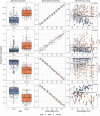Epigenetics underpins phenotypic plasticity of protandrous sex change in fish
- PMID: 35342607
- PMCID: PMC8931711
- DOI: 10.1002/ece3.8730
Epigenetics underpins phenotypic plasticity of protandrous sex change in fish
Abstract
Phenotypic plasticity is an important driver of species resilience. Often mediated by epigenetic changes, phenotypic plasticity enables individual genotypes to express variable phenotypes in response to environmental change. Barramundi (Lates calcarifer) are a protandrous (male-first) sequential hermaphrodite that exhibits plasticity in length-at-sex change between geographic regions. This plasticity is likely to be mediated by changes in DNA methylation (DNAm), a well-studied epigenetic modification. To investigate the relationships between length, sex, and DNAm in a sequential hermaphrodite, here, we compare DNAm in four conserved vertebrate sex-determining genes in male and female barramundi of differing lengths from three geographic regions of northern Australia. Barramundi first mature as male and later sex change to female upon the attainment of a larger body size; however, a general pattern of increasing female-specific DNAm markers with increasing length was not observed. Significant differences in DNAm between males and females of similar lengths suggest that female-specific DNAm arises rapidly during sex change, rather than gradually with fish growth. The findings also reveal that region-specific differences in length-at-sex change are accompanied by differences in DNAm and are consistent with variability in remotely sensed sea temperature and salinity. Together, these findings provide the first in situ evidence for epigenetically and environmentally mediated sex change in a protandrous hermaphrodite and offer significant insight into the molecular and ecological processes governing the marked and unique plasticity of sex in fish.
Keywords: DNA methylation; ecological adaptation; phenotypic plasticity; sex change; teleost; temperature.
© 2022 The Authors. Ecology and Evolution published by John Wiley & Sons Ltd.
Conflict of interest statement
The authors declare that they are not aware of any competing interests.
Figures




Similar articles
-
Sex-specific dmrt1 and cyp19a1 methylation and alternative splicing in gonads of the protandrous hermaphrodite barramundi.PLoS One. 2018 Sep 18;13(9):e0204182. doi: 10.1371/journal.pone.0204182. eCollection 2018. PLoS One. 2018. PMID: 30226860 Free PMC article.
-
Faster juvenile growth promotes earlier sex change in a protandrous hermaphrodite (barramundi Lates calcarifer).Sci Rep. 2021 Jan 26;11(1):2276. doi: 10.1038/s41598-021-81727-1. Sci Rep. 2021. PMID: 33500452 Free PMC article.
-
Rapid Neural DNA Methylation Responses to Predation Stress in Trinidadian Guppies.Mol Ecol. 2025 May;34(10):e17774. doi: 10.1111/mec.17774. Epub 2025 Apr 25. Mol Ecol. 2025. PMID: 40277378 Free PMC article.
-
Molecular and cellular regulation on sex change in hermaphroditic fish, with a special focus on protandrous black porgy, Acanthopagrus schlegelii.Mol Cell Endocrinol. 2021 Jan 15;520:111069. doi: 10.1016/j.mce.2020.111069. Epub 2020 Oct 27. Mol Cell Endocrinol. 2021. PMID: 33127483 Review.
-
The Genetics and Epigenetics of Sex Change in Fish.Annu Rev Anim Biosci. 2020 Feb 15;8:47-69. doi: 10.1146/annurev-animal-021419-083634. Epub 2019 Sep 16. Annu Rev Anim Biosci. 2020. PMID: 31525067 Review.
Cited by
-
Ecological consequences of body size reduction under warming.Proc Biol Sci. 2024 Aug;291(2029):20241250. doi: 10.1098/rspb.2024.1250. Epub 2024 Aug 21. Proc Biol Sci. 2024. PMID: 39166384 Free PMC article. Review.
-
Optimization of a non-activating medium for short-term chilled storage of barramundi (Lates calcarifer) testicular spermatozoa.Fish Physiol Biochem. 2023 Aug;49(4):559-576. doi: 10.1007/s10695-023-01191-8. Epub 2023 May 17. Fish Physiol Biochem. 2023. PMID: 37193910 Free PMC article.
-
Characterization of the Pristionchus pacificus "epigenetic toolkit" reveals the evolutionary loss of the histone methyltransferase complex PRC2.Genetics. 2024 May 7;227(1):iyae041. doi: 10.1093/genetics/iyae041. Genetics. 2024. PMID: 38513719 Free PMC article.
References
-
- Athauda, S. , & Anderson, T. (2014). Effect of temperature and salinity on sex inversion in Asian Seabass (Lates calcarifer): Relationship with plasma sex steroids concentration and aromatase activity of gonad and brain. Aquaculture Research.
-
- Australian Institute of Marine Science (AIMS) (2017). AIMS Sea Water Temperature Observing System (AIMS Temperature Logger Program). 10.25845/5b4eb0f9bb848accessed. 21‐May‐2021. - DOI
-
- Banh, Q. Q. , Guppy, J. L. , Domingos, J. A. , Budd, A. M. , Pinto, R. C. , Marc, A. F. , & Jerry, D. R. (2021). Induction of precocious females in the protandrous barramundi (Lates calcarifer) through implants containing 17β‐estradiol‐effects on gonadal morphology, gene expression and DNA methylation of key sex genes. Aquaculture, 539, 736601. 10.1016/j.aquaculture.2021.736601 - DOI
Associated data
LinkOut - more resources
Full Text Sources

